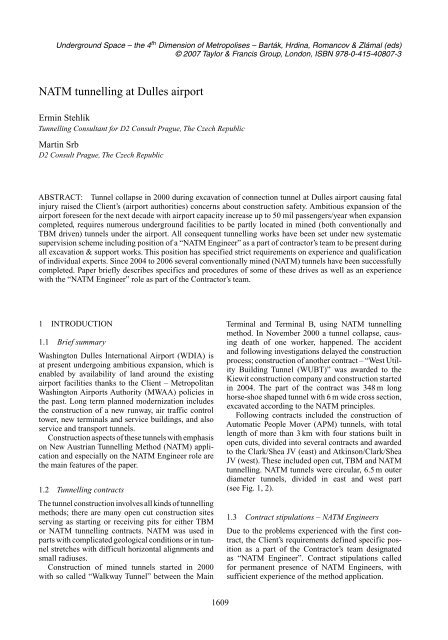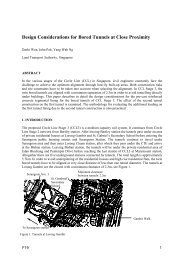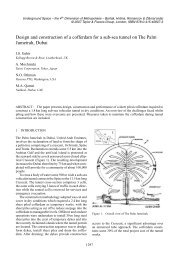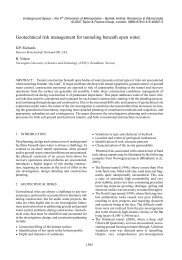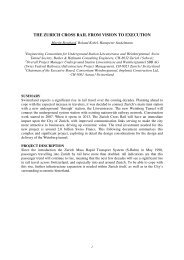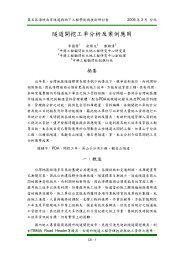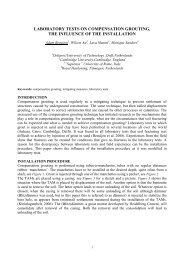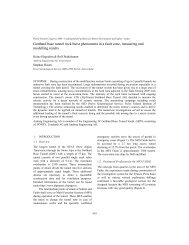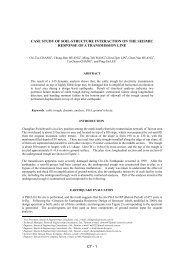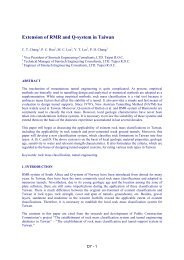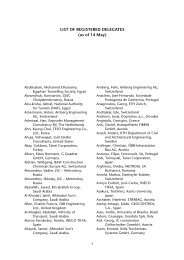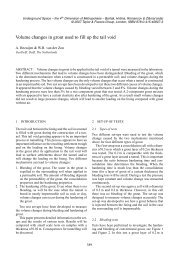NATM tunnelling at Dulles airport
NATM tunnelling at Dulles airport
NATM tunnelling at Dulles airport
You also want an ePaper? Increase the reach of your titles
YUMPU automatically turns print PDFs into web optimized ePapers that Google loves.
Underground Space – the 4 th Dimension of Metropolises – Barták, Hrdina, Romancov & Zlámal (eds)<br />
© 2007 Taylor & Francis Group, London, ISBN 978-0-415-40807-3<br />
<strong>NATM</strong> <strong>tunnelling</strong> <strong>at</strong> <strong>Dulles</strong> <strong>airport</strong><br />
Ermin Stehlik<br />
Tunnelling Consultant for D2 Consult Prague, The Czech Republic<br />
Martin Srb<br />
D2 Consult Prague, The Czech Republic<br />
ABSTRACT: Tunnel collapse in 2000 during excav<strong>at</strong>ion of connection tunnel <strong>at</strong> <strong>Dulles</strong> <strong>airport</strong> causing f<strong>at</strong>al<br />
injury raised the Client’s (<strong>airport</strong> authorities) concerns about construction safety. Ambitious expansion of the<br />
<strong>airport</strong> foreseen for the next decade with <strong>airport</strong> capacity increase up to 50 mil passengers/year when expansion<br />
completed, requires numerous underground facilities to be partly loc<strong>at</strong>ed in mined (both conventionally and<br />
TBM driven) tunnels under the <strong>airport</strong>. All consequent <strong>tunnelling</strong> works have been set under new system<strong>at</strong>ic<br />
supervision scheme including position of a “<strong>NATM</strong> Engineer” as a part of contractor’s team to be present during<br />
all excav<strong>at</strong>ion & support works. This position has specified strict requirements on experience and qualific<strong>at</strong>ion<br />
of individual experts. Since 2004 to 2006 several conventionally mined (<strong>NATM</strong>) tunnels have been successfully<br />
completed. Paper briefly describes specifics and procedures of some of these drives as well as an experience<br />
with the “<strong>NATM</strong> Engineer” role as part of the Contractor’s team.<br />
1 INTRODUCTION<br />
1.1 Brief summary<br />
Washington <strong>Dulles</strong> Intern<strong>at</strong>ional Airport (WDIA) is<br />
<strong>at</strong> present undergoing ambitious expansion, which is<br />
enabled by availability of land around the existing<br />
<strong>airport</strong> facilities thanks to the Client – Metropolitan<br />
Washington Airports Authority (MWAA) policies in<br />
the past. Long term planned moderniz<strong>at</strong>ion includes<br />
the construction of a new runway, air traffic control<br />
tower, new terminals and service buildings, and also<br />
service and transport tunnels.<br />
Construction aspects of these tunnels with emphasis<br />
on New Austrian Tunnelling Method (<strong>NATM</strong>) applic<strong>at</strong>ion<br />
and especially on the <strong>NATM</strong> Engineer role are<br />
the main fe<strong>at</strong>ures of the paper.<br />
1.2 Tunnelling contracts<br />
The tunnel construction involves all kinds of <strong>tunnelling</strong><br />
methods; there are many open cut construction sites<br />
serving as starting or receiving pits for either TBM<br />
or <strong>NATM</strong> <strong>tunnelling</strong> contracts. <strong>NATM</strong> was used in<br />
parts with complic<strong>at</strong>ed geological conditions or in tunnel<br />
stretches with difficult horizontal alignments and<br />
small radiuses.<br />
Construction of mined tunnels started in 2000<br />
with so called “Walkway Tunnel” between the Main<br />
1609<br />
Terminal and Terminal B, using <strong>NATM</strong> <strong>tunnelling</strong><br />
method. In November 2000 a tunnel collapse, causing<br />
de<strong>at</strong>h of one worker, happened. The accident<br />
and following investig<strong>at</strong>ions delayed the construction<br />
process; construction of another contract – “West Utility<br />
Building Tunnel (WUBT)” was awarded to the<br />
Kiewit construction company and construction started<br />
in 2004. The part of the contract was 348 m long<br />
horse-shoe shaped tunnel with 6 m wide cross section,<br />
excav<strong>at</strong>ed according to the <strong>NATM</strong> principles.<br />
Following contracts included the construction of<br />
Autom<strong>at</strong>ic People Mover (APM) tunnels, with total<br />
length of more than 3 km with four st<strong>at</strong>ions built in<br />
open cuts, divided into several contracts and awarded<br />
to the Clark/Shea JV (east) and Atkinson/Clark/Shea<br />
JV (west). These included open cut, TBM and <strong>NATM</strong><br />
<strong>tunnelling</strong>. <strong>NATM</strong> tunnels were circular, 6.5 m outer<br />
diameter tunnels, divided in east and west part<br />
(see Fig. 1, 2).<br />
1.3 Contract stipul<strong>at</strong>ions – <strong>NATM</strong> Engineers<br />
Due to the problems experienced with the first contract,<br />
the Client’s requirements defined specific position<br />
as a part of the Contractor’s team design<strong>at</strong>ed<br />
as “<strong>NATM</strong> Engineer”. Contract stipul<strong>at</strong>ions called<br />
for permanent presence of <strong>NATM</strong> Engineers, with<br />
sufficient experience of the method applic<strong>at</strong>ion.
Figure 1. General <strong>Dulles</strong> <strong>airport</strong> layout.<br />
Figure 2. Typical cross section of <strong>NATM</strong> APM tunnel.<br />
The situ<strong>at</strong>ion in the US <strong>tunnelling</strong> market driven by<br />
the low cost rule, with few <strong>NATM</strong> tunnels, resulted<br />
in shortage of suitably qualified engineers and tunnel<br />
workers. Even the largest companies are commonly<br />
hiring external specialists for <strong>tunnelling</strong> contracts.<br />
Position of <strong>NATM</strong> Engineers for both mentioned<br />
contracts were subcontracted to the Austrian tunnel<br />
consultants D2 Consult, and through its daughter<br />
company D2 Consult Prague, several Czech tunnel<br />
engineers worked on the project as a part of the<br />
contractor’s teams.<br />
2 TUNNEL CONSTRUCTION<br />
2.1 Geological and Hydrological conditions<br />
Geological conditions for the tunnel construction<br />
are rel<strong>at</strong>ively favourable. The bedrock, in which the<br />
1610<br />
Figure 3. Typical face conditions.<br />
tunnels have been predominantly mined, consists<br />
mainly of competent hard mudstone and claystone,<br />
with few sets of joints and UCS range between<br />
20–40 MPa. Only <strong>at</strong> limited loc<strong>at</strong>ions rock we<strong>at</strong>hering<br />
process cre<strong>at</strong>ed softer soil with clay characteristic.<br />
The earlier conventional <strong>tunnelling</strong> <strong>at</strong> the <strong>airport</strong><br />
was performed using drill&blast excav<strong>at</strong>ion technique,<br />
with large amount of explosives used, significantly disturbing<br />
the surrounding rock. As a result, when crossing<br />
in the vicinity of previous construction works with<br />
newly built tunnels, excav<strong>at</strong>ion and support install<strong>at</strong>ion<br />
have to consider earlier affected broken rock<br />
conditions.<br />
Massive mudstone and claystone were during<br />
excav<strong>at</strong>ion rel<strong>at</strong>ively dry, the w<strong>at</strong>er penetr<strong>at</strong>ed into<br />
the excav<strong>at</strong>ion only through joints and was rel<strong>at</strong>ed to<br />
surface precipit<strong>at</strong>ion.<br />
2.2 TBM <strong>tunnelling</strong><br />
There were several contracts, in whichTBM <strong>tunnelling</strong><br />
with bolted precast segmental lining assembled in<br />
the TBM shield has been used. The l<strong>at</strong>est technology<br />
for the segment production has been introduced;<br />
for the tunnel lining w<strong>at</strong>er tightness the modern sealing<br />
systems with rubber sealing gaskets have been<br />
applied.<br />
2.3 <strong>NATM</strong> <strong>tunnelling</strong><br />
2.3.1 Generally<br />
Designed support classes (I–III) for the tunnel excav<strong>at</strong>ion<br />
and support were applied according to the <strong>NATM</strong><br />
Engineer’s decision.<br />
Both, horseshoe and circular tunnels were excav<strong>at</strong>ed<br />
in two steps. Firstly, the top heading was excav<strong>at</strong>ed<br />
and support measures as specified for the initial lining<br />
applied. In the second step the invert was excav<strong>at</strong>ed<br />
and initial lining completed.
2.3.2 Excav<strong>at</strong>ion<br />
The excav<strong>at</strong>ion in all contracts was done by roadheaders,<br />
blasting was strictly prohibited.There were several<br />
types of roadheaders, mostly Voest Alpine models AM<br />
75 for large profiles andAM 50 for e.g. invert and final<br />
profiling.<br />
2.3.3 Support Classes<br />
The following description is rel<strong>at</strong>ed to the APM<br />
contract.<br />
The round length was corresponding to the applied<br />
Support Class. In the Support Class I, which was used<br />
for massive sound rock, this length was 1.5 m; and <strong>at</strong><br />
the same distance l<strong>at</strong>tice girders were erected. Initial<br />
lining was formed by 15 cm thick shotcrete with steel<br />
fibres.<br />
In the Support Class II, applied for jointed rock,<br />
4 m long spiles were installed in each round to prevent<br />
loosening of the rock blocks and their falling<br />
from the excav<strong>at</strong>ion roof. Round length was 1.2 m,<br />
shotcrete thickness 20 cm, l<strong>at</strong>tice girders <strong>at</strong> 1.2 m distance.<br />
Probing ahead of the face was performed every<br />
fourth round, the length of probe drill hole was 12 m.<br />
Support Class III was applied when the tunnel profile<br />
entered into the area of heavily we<strong>at</strong>hered rock<br />
having character of clay. The round length was 0.9 m<br />
and the pre-support measure consisted of grouted<br />
steel pipe umbrella length of 9.0 m. In some cases<br />
the Support Class III was applied during <strong>tunnelling</strong><br />
under other structures or utilities as a safety precaution<br />
measure.<br />
Bolting was considered as an additional measure,<br />
bolts install<strong>at</strong>ion was based on <strong>NATM</strong> Engineer’s decision.<br />
SN bolts installed into boreholes fastened with<br />
resin cartridges have been applied.<br />
2.3.4 Shotcrete<br />
There were b<strong>at</strong>ching plant directly on the site; mixing<br />
of the wet shotcrete mix was done in truck-mixers.<br />
From the trucks the shotcrete was delivered to the<br />
stable pump loc<strong>at</strong>ed on the surface. From the pump<br />
the shotcrete was pumped by delivery line (slick line)<br />
to the shotcrete spraying robot with remote control,<br />
close to the tunnel face. Acceler<strong>at</strong>or was delivered to<br />
the nozzle by small pump <strong>at</strong> acceler<strong>at</strong>or storage tank.<br />
2.3.5 Final lining<br />
Final lining was made of reinforced cast in situ<br />
concrete of 30 cm thickness. Specific fe<strong>at</strong>ure was<br />
universal use of corrosion protection co<strong>at</strong> of all reinforcement<br />
bars. Between shotcrete and final lining<br />
a w<strong>at</strong>erproofing membrane was installed.<br />
2.3.6 Problems during <strong>tunnelling</strong><br />
The biggest problem encountered during <strong>tunnelling</strong><br />
was shotcrete delivery to the tunnel face. Due to the<br />
pump loc<strong>at</strong>ion on the surface, the delivery lines were<br />
1611<br />
Figure 4. Finished final lining of east APM tunnel.<br />
long, with many bends. They were also exposed to the<br />
he<strong>at</strong> or cold conditions and as a result there were many<br />
blockages on the lines, leading to delays in shotcrete<br />
delivery. Very often the problems with acceler<strong>at</strong>or<br />
dosage caused delays during shotcrete applic<strong>at</strong>ion.<br />
The biggest problem, from the <strong>NATM</strong> Engineer’s<br />
point of view was long time period required for<br />
shotcrete support applic<strong>at</strong>ion in the cases of unstable<br />
rock conditions.<br />
Another problem was presence of w<strong>at</strong>er in the tunnel,<br />
affecting the conditions of the temporary top<br />
heading invert. The w<strong>at</strong>er was mainly technological<br />
w<strong>at</strong>er from the roadheader spraying the face during<br />
cutting; the w<strong>at</strong>er used for cleaning and in some cases<br />
the w<strong>at</strong>er coming from the portal areas. As a result<br />
there was permanently thick layer of mud on the tunnel<br />
invert, making the working conditions difficult.<br />
Applic<strong>at</strong>ion of roadheaders for the tunnel excav<strong>at</strong>ion<br />
did not allow for partial suitable excav<strong>at</strong>ion of<br />
the face. In some cases, it would be advantageous to<br />
excav<strong>at</strong>e only top part of the face and apply shotcrete<br />
layer to support unstable rock. With the roadheader,<br />
the excav<strong>at</strong>ion had to start <strong>at</strong> the lower part to cre<strong>at</strong>e<br />
the space for roadheader apron, to allow cutting boom<br />
reaching the top of the face.<br />
Typical tunnel worker has not <strong>NATM</strong> <strong>tunnelling</strong><br />
experience and is trained for required specific skills<br />
before project starts. Also Trade Union labour rules<br />
make it r<strong>at</strong>her difficult to use available labour force in<br />
tunnel with required flexibility and efficiency.<br />
3 <strong>NATM</strong> ENGINEER POSITION<br />
The <strong>NATM</strong> Engineer is a specific position, present<br />
in the moment only on the USA <strong>tunnelling</strong> market,<br />
therefore brief explan<strong>at</strong>ion of his position and role follows,<br />
together with few comments based on experience<br />
gained on the <strong>Dulles</strong> Airport contracts.
Generally, the <strong>NATM</strong> Engineer could be characterized<br />
as bearer of <strong>NATM</strong> know-how, who is responsible<br />
for effective and safe applic<strong>at</strong>ion of the method. There<br />
are strict criterions stipul<strong>at</strong>ed in the contract documents<br />
as far as the <strong>NATM</strong> Engineer qualific<strong>at</strong>ion<br />
and experience is concerned (years of experience,<br />
type of works done, both design and site experience<br />
requirement, etc.).<br />
Actual role of the <strong>NATM</strong> Engineer on <strong>Dulles</strong> Airport<br />
<strong>tunnelling</strong> contract encompassed few more tasks.<br />
<strong>NATM</strong> Engineer provided also geological mapping of<br />
tunnel faces and monitored probe drilling in relevant<br />
support classes. He was taking decision on wh<strong>at</strong> support<br />
class will be applied for given conditions and<br />
also about any additional measures required (additional<br />
shotcrete, bolting). Part of his responsibility<br />
was evalu<strong>at</strong>ing the results of geotechnical monitoring<br />
(deform<strong>at</strong>ion measurements) and proposing relevant<br />
measures to react on the results.<br />
<strong>NATM</strong> Engineer was an important partner during<br />
technical discussions and negoti<strong>at</strong>ions with the<br />
Client’s Represent<strong>at</strong>ive, who was <strong>at</strong> <strong>Dulles</strong> Airport<br />
project called Project Management Consultant (PMC).<br />
In the PMC team there was highly qualified intern<strong>at</strong>ional<br />
staff with long term experience regarding<br />
<strong>NATM</strong> <strong>tunnelling</strong>.<br />
Two years project experience demonstr<strong>at</strong>ed importance<br />
of the newly established position. Responsibility<br />
of the <strong>NATM</strong> Engineer was quite high and his<br />
activity significant, especially in the case of worsening<br />
geological conditions and a need to take and<br />
imply quickly the decisions in respect of changing<br />
to another support class or to apply additional<br />
1612<br />
support or excav<strong>at</strong>ion measures. Although a part of<br />
contractor’s team, quite understandably sometimes the<br />
priorities of both subjects (<strong>NATM</strong> Engineer vs. Contractor’s<br />
management) were slightly different.This fact<br />
was also confirmed <strong>at</strong> the meetings with PMC an/or<br />
Client, where <strong>NATM</strong> Engineer’s position and reasoning<br />
were considered by the parties as r<strong>at</strong>her neutral and<br />
objective, not much affected by project economical<br />
interests.<br />
From the personal experience, a serious problem<br />
for the <strong>NATM</strong> Engineer was to get support measures<br />
done as fast as possible and in required quality. This<br />
is valid mainly for the timely shotcrete delivery in the<br />
case of unstable rock conditions.To improve and acceler<strong>at</strong>e<br />
this process was beyond the <strong>NATM</strong> Engineer<br />
capability and competence, although he was generally<br />
responsible for proper and timely applic<strong>at</strong>ion and safe<br />
and stable conditions.<br />
4 CONCLUSION<br />
The presence of “<strong>NATM</strong> Engineers” on the <strong>Dulles</strong><br />
<strong>airport</strong> <strong>tunnelling</strong> contracts definitely contributed to<br />
safe realiz<strong>at</strong>ion of WUBT and APM conventionally<br />
driven tunnels. European <strong>tunnelling</strong> experts experienced<br />
working in different contractual environment<br />
and different working conditions with respect to local<br />
workforce experience with <strong>NATM</strong>, <strong>tunnelling</strong> qualific<strong>at</strong>ion,<br />
and local practises. It is probable th<strong>at</strong> on follow<br />
up <strong>tunnelling</strong> contracts on <strong>Dulles</strong> extension, the same<br />
or similar model of <strong>NATM</strong> expert working directly for<br />
contractor shall be applied.


